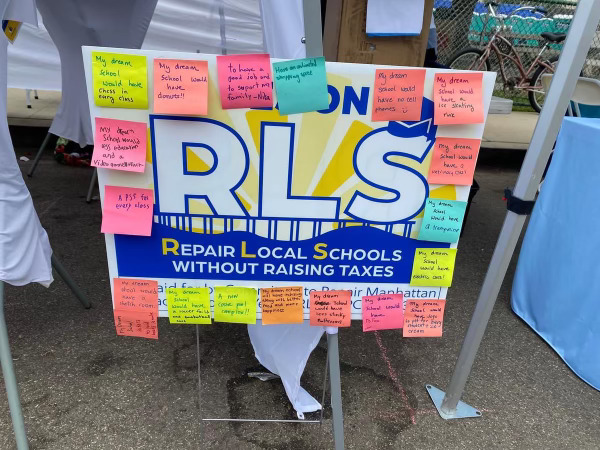by Mark McDermott
The campaign for Measure RLS is offering a multi-pronged argument in favor of the $200 million school bond appearing on the November 5 ballot.
The first part is the necessity of upgrades, which range from healthier drinking water, bigger kindergarten classrooms with bathrooms attached, no more leaky roofs, and state-of-the-art science labs at all campuses.
“One, we want your kids to be safe in these schools,” said Larry Zimbalist, chair of the Yes on RLS campaign. “There are so many older aspects to the schools, such as the drinking water. The other part is, we want to put these kids in classrooms that will enhance their ability to learn and ultimately enhance their ability to compete in the modern world.”
The other part is the bond measure’s timing and economics. Because Measure RLS comes as two-decade old school bonds come off the books and in an election when a state bond measure, Proposition 2, offers matching funds to school districts that pass bond measures — if RLS passes, residents will see no increase in taxes, and with the matching funds, current interest rates, and developers fees, the Manhattan Beach Unified School District will receive an estimated $275 million in funds for upgrades based on the $200 million school bond.
“When you can get $200 million without raising taxes and it turns into $275 million, it’s a pretty good situation,” Zimbalist said.
No organized opposition has emerged to Measure RLS. Meanwhile, it has achieved something rare in local politics. Every elected official in Manhattan Beach, which includes City Council, School Board, and City Treasurer Tim Lilligren, has endorsed it. Congressman Ted Lieu and Assemblyman Al Muratsuchi have endorsed it. Additionally, all six candidates running for City Council support it, as does school board candidate Jen Dohner, who is running without opposition. Former mayor Russ Lesser, still influential, not only supports Measure RLS but threw a fundraiser for the campaign at his and his wife Charlotte’s home.
“We’ve got the leaders of the community who are backing us,” said Zimbalist. “It’s pretty amazing.”
Mayor Joe Franklin appeared at the school board meeting last week to show his support.
“It’s important to provide adequate, safe, and functional buildings and infrastructure to maintain the success of our schools and the health of our children, teachers and staff,” Franklin said. “And yes, a fact that I can testify to personally — our excellent schools make a highly desirable place to live and drive our real estate values higher. My family has benefited from both an excellent education for our now adult children and a steady increase in the value of our home.”
Proposition 2 has enticed school districts across the state to put bond measures on the November ballot, including neighboring school districts in Hermosa Beach, Redondo Beach and Palos Verdes. Hermosa is seeking $27.8 million. RBUSD is seeking $278 million and PVUSD $298.7 million. Another similarly high performing school district, Pasadena, is seeking “a cool $900 million,” Zimbalist noted.
“There are over 200 districts in California that are all in for a facilities bond,” Zimbalist said. “They all recognize the opportunity of passing Prop. 2. Then, basically, the cashier’s window is wide open, and the state wants you to show up. Now, what do you have to do? You need two things. You need a facility master plan, because the master plan will identify the matching opportunities, and you need to pass a facilities bond. You need to hand it off to your community, and your community needs to jump on this, come together, and be willing to put this on their property taxes.”
The advantage MBUSD has that most districts don’t is that Manhattan Beach residents won’t see a change in their property tax bills. (Hermosa Beach is similarly extending, but not increasing its school property tax.)
Zimbalist said the other key factor voters should bear in mind is that the school bonds approved in 2016, Measures C and EE, both resulted in significant work that came in on time and under budget, due to effective oversight and because the district has contractors and architects, including Balfour Beaty and the DLR Group, who’ve become trusted, longtime partners.
Those bond measures, however, at the time left $153 million in unmet facilities’ needs. MBUSD’s recently updated Facilities Master Plan has identified $400 million in needed upgrades. The Master Plan, which is viewable at MBUSDplan.com, details conditions at every campus and projects a 20 year timeline of needs, and shows photos of some of the most urgent needs — frayed floors, holes in roofs, rusted out water heaters, modular classrooms at the end of their functional lives, and outdated classrooms. One of the pushes at the state level, which includes up to 65 percent matching, is to expand the size of kindergarten classrooms, and for each to include restrooms, since young students miss instruction due to frequent trips to the restroom.
Zimbalist argues that this unique array of circumstances will not come again.
“This is the moment that we can obtain these funds without raising taxes,” he said. “This is a moment where we can go directly towards that cashier’s window for the match. And this is also a wonderful moment in time because, though our facilities are deteriorated and older, they haven’t fallen apart. We’re not at the point of having to have emergency work done. But if we don’t do anything, that is around the corner. This is exactly the time to build on what we did with Measure C and EE and the success that we had there. It’s a moment in time for several reasons.” ER






